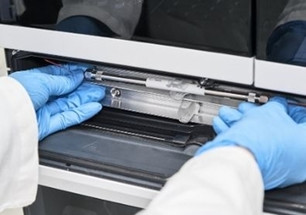Posted by Chrom Tech on 14th Oct 2025
How To Maximize HPLC Column Lifetime
All HPLC columns experience gradual wear over time. Factors such as sample injections, residual proteins, lipids, and particulates can accumulate inside the column, leading to increased backpressure and reduced efficiency. Even the mobile phase and the LC system itself can introduce fine debris that accelerates deterioration. Fortunately, with proper maintenance and sample preparation, you can significantly extend column life and ensure consistent, high-quality chromatographic results.
Sample Preparation and Clean-Up
Proper sample preparation is the foundation of long column life. Clean-up steps remove particulates, salts, and matrix residues that could foul the stationary phase. Common preparation techniques include solid-phase extraction (SPE), liquid-liquid extraction (LLE), and syringe filtration.
- Solid-Phase Extraction (SPE): Uses a solid sorbent cartridge to remove contaminants prior to analysis, ensuring cleaner injections.
- Liquid-Liquid Extraction (LLE): Separates analytes into an immiscible phase for selective isolation of compounds of interest.
- Syringe Filtration: Employs Chrom Tech syringe filters to remove particulates before injection, protecting your HPLC column from clogging.
For a one-step alternative, Chrom Tech offers filter vials that combine filtration and vial loading in a single process—perfect for high-throughput workflows. For automated sample prep, filter plates provide efficient, scalable filtration for 96-well formats.
Solvent and Buffer Procedures
Using clean, freshly prepared solvents and properly filtered buffers is critical to maximizing column longevity. Stale or contaminated mobile phases can promote bacterial growth or introduce particulates that damage the column bed.
Always filter freshly made buffers to remove salt precipitation and particulate matter. Additionally, maintain the manufacturer-recommended pH range for your column. For example, excessively low pH can hydrolyze the bonded phase, while excessively high pH can dissolve silica, both of which reduce column efficiency and retention performance.
Using Filters and Guard Columns
Multiple filtration points throughout your HPLC system help protect the analytical column from particulate buildup:
- Inline Solvent Filters: Positioned between the pump and injector to trap debris before it enters the flow path.
- Pre-Column Filters: Installed immediately before the column to remove any remaining particulates from the sample stream.
- Guard Columns: Miniature columns with matching stationary phase that capture contaminants before they reach the analytical column. Explore Chrom Tech guard columns to extend the life of your analytical column.
Follow Operating Conditions
Adhering to the column manufacturer’s operating specifications is essential. Each HPLC column has specific limits for pH, temperature, and pressure. Operating beyond these parameters shortens column life and compromises reproducibility.
For instance, silica-based reversed-phase packings are typically stable at room temperature within a pH range of 2 to 8. Hybrid-silica materials, however, can tolerate pH 1–12. Increasing temperature near either pH limit accelerates degradation. Always review your column’s technical manual for best practices on solvent compatibility, sample loading, and storage.
Summary
By combining proper sample preparation, solvent maintenance, filtration, and adherence to operating conditions, you can significantly extend your HPLC column’s lifespan. Protect your investment with quality consumables like syringe filters, filter vials, and filter plates—all designed for efficiency and performance from Chrom Tech.
Frequently Asked Questions About HPLC Column Maintenance
How can I tell when my HPLC column needs replacement?
Signs include increased system backpressure, peak broadening, poor resolution, or changing retention times. If performance declines even after replacing filters or guards, it’s time to replace the column.
How do syringe filters help extend column life?
Syringe filters remove particulates and proteins before injection, preventing clogs and pressure buildup that damage the stationary phase. Chrom Tech offers multiple membrane types to match your sample’s solvent compatibility.
What pH range is safe for silica-based columns?
Standard silica columns perform best between pH 2 and 8. Hybrid-silica materials extend usability from pH 1 to 12, but always confirm your specific column’s tolerance range.
How can I prevent bacterial growth in mobile phases?
Always prepare fresh solvents and store them in clean, sealed containers. Use organic modifiers when possible and replace aqueous buffers frequently to avoid microbial contamination.

